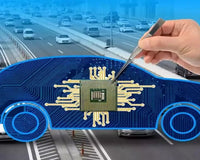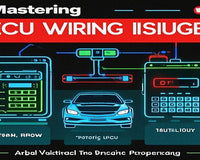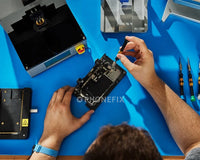In the intricate world of automotive technology, Car Engine Control Units (ECUs) play a pivotal role in ensuring optimal vehicle performance. However, like any complex electronic component, ECUs are prone to various defects. In this blog, we'll explore the common defects in car ECUs that can be identified using a microscope.
What ECU defects can be found under a microscope?
Component Damage.
One of the most common issues visible under a microscope is component damage. Resistors, capacitors, and integrated circuits (ICs) on the ECU circuit board can suffer physical damage due to impacts, vibrations, or overheating during the vehicle's operation. Microscopic inspection can reveal cracked resistors, bulging or leaking capacitors, and broken pins on ECU ICs. These damages can disrupt the electrical signals within the ECU, leading to performance issues or even complete ECU failure. If a resistor appears cracked under the microscope, a multimeter can measure its actual resistance value to confirm if it has deviated from the specified value. 
Solder Joint Problems.
Solder joints connect electronic components to the circuit board. Microscopes are excellent for detecting solder joint defects such as cold solder joints, solder bridges, and insufficient solder. These solder joint issues can be extremely difficult to spot with the naked eye but are clearly visible under a microscope, allowing technicians to repair or rework the joints for a reliable ECU operation.
Corrosion.
Exposure to moisture, contaminants, or a harsh automotive environment can cause corrosion on the ECU circuit board. Microscopic examination can detect signs of corrosion, such as greenish - brown patches on copper traces or component leads. Corrosion gradually eats away at the metal, reducing the conductivity of the circuit and potentially causing open circuits. 
While microscopes are great for visual inspection of physical defects, thermal imagers provide a different perspective by detecting abnormal heat patterns. A malfunctioning component in the ECU, such as a short - circuited transistor or an overloaded power supply, will generate more heat than normal. Thermal imagers can quickly identify these hotspots, helping technicians narrow down the location of potential problems. In addition, you can also use the XTOOL D6S automotive full system diagnostic scan tool to quickly read and retrieve ECU fault codes, providing valuable clues about the location and type of defects.
Microscopes are a crucial tool for detecting common defects in car ECUs, such as component damage, solder joint problems, and corrosion.With the help of microscopes, automotive technicians can effectively identify and repair ECU issues, ensuring the smooth and reliable operation of vehicles. Whether you're a professional mechanic or an automotive enthusiast, understanding these diagnostic methods can help you maintain and troubleshoot your vehicle's ECU more effectively.
How Microscopes Uncover Hidden Flaws in Car ECUs?










